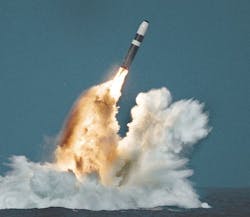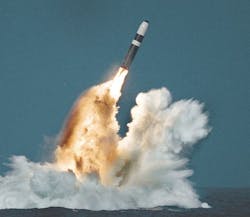Officials of the Navy Strategic Systems Program office in Washington are asking Lockheed Martin to provide new procurement of Trident II D5 missile production, D5 life extension development and production, and D5 deployed systems support.
The contract, announced on 19 Sept., is for $146.3 million. With options the contract ultimately could be worth $828.4 million. The missiles are for U.S. Navy Ohio-class ballistic missile submarines and Vanguard-class ballistic missile submarines of the United Kingdom Royal Navy.
The Trident II is the primary weapon aboard Navy Ohio-class submarines -- the so-called "boomers." The missile has a range of more than 7,000 miles and carries four independently targeted 475-kiloton nuclear warheads -- each of which can discharge the energy of 475,000 tons of TNT, and is roughly 30 times the size of the U.S. nuclear bomb dropped on Hiroshima, Japan, in 1945.
The missile has a range longer than 7,000 miles; has a maximum speed of 13,000 miles per hour, and has precision guidance from inertial sensors with star sighting. No GPS-guided Trident D5 missiles have been deployed.
Each Ohio-class submarine can carry as many as 24 Trident II missiles, while the Royal Navy Vanguard-class submarines can carry as many as 16 Tridents. The Ohio-class submarine has the power to destroy nearly 100 large- and medium-size cities, and by far is the single most powerful weapon system in the U.S. arsenal.
The contract modification to Lockheed Martin announced this month involves federal fiscal year 2014 Trident II missile procurement and support.
Related: Nuclear ballistic missile command and control technology still a prime military concern
The contract calls for 68 Trident II D5 missile body assemblies, 24 missile inverters, two active inert missile body sections, 14 test missile kits, eight D5 reentry body Strategic Program Alteration (SPALT) kits, and other various parts and subsystems.
On this contract Lockheed Martin will do the work in Sunnyvale, Calif.; Magna, Utah; Kings Bay, Ga.; Cape Canaveral, Fla.; Culpeper, Va.; Silverdale, Wash.; Bloomington, Minn.; Kingsport, Tenn.; El Segundo, Calif.; Lancaster, Pa.; Oakridge, Tenn.; and other locations, and should be finished by November 2019.
For more information contact Lockheed Martin Space Systems online at www.lockheedmartin.com/us/ssc, or the Navy Strategic Systems Program office at www.ssp.navy.mil.




